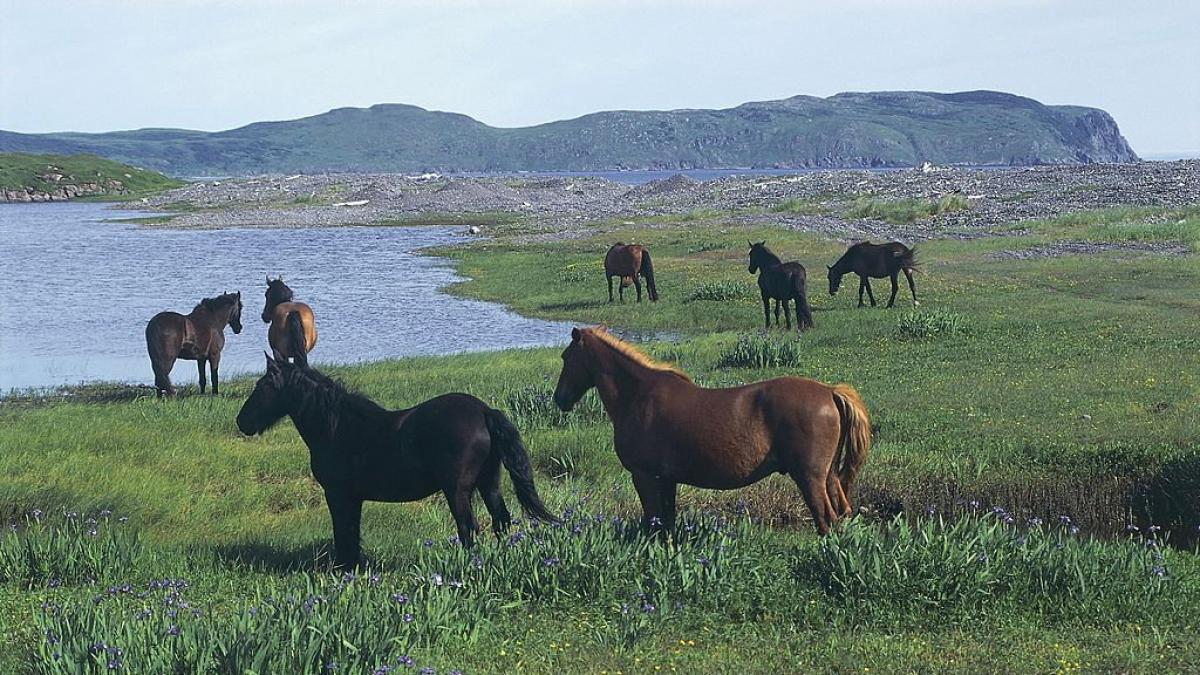The islands
Ob Baguette, Camembert or Bordeaux – in the shops and restaurants of Saint-Pierre and Miquelon everything is paid for in euros. That alone makes the small archipelago in the North Atlantic exotic for North American day visitors. When they board the ferry in Newfoundland and cross over to the port city of Saint-Pierre, 25 kilometers away, they step onto European soil, so to speak. Because the landmass totaling 237 square kilometers (which corresponds to one and a half times the size of Fehmarn) is a French overseas territory (collectivité d’outre-mer); it enjoys autonomy and sends representatives to the French Parliament.
Historically, St-Pierre and Miquelon is what remains of the once vast colony of New France in North America, which at its peak in the early 17th century stretched from Newfoundland to the Rocky Mountains and from Hudson Bay to the Gulf of Mexico. The Treaty of Utrecht in 1713 and the Treaty of Paris in 1763 forced France to cede almost all of its possessions to Great Britain and Spain; even for the last colony of St. Pierre and Miquelon, the French wrestled with the British for several more decades.
It wasn’t so much about the barren islands themselves, which were only covered with fir trees, but about the rich fishing grounds around them – which, however, were already considered overfished in the 1960s. In 1992, Canada imposed a ban on fishing within 200 miles of Newfoundland to regenerate stocks, which the St-Pierrais had to follow at French behest. This made the archipelago dependent on subsidies from the mother country – and on tourism.
Since 2019 there has been a non-stop flight connection from Paris in the summer months, and cruise ships also dock regularly. Visitors can spot seabirds on hikes and whales on cruises. With its restaurants, shops and museums (around the time of Prohibition, when Saint-Pierre was a smuggler’s paradise), the French exclave is also ideal for stopovers.
Cold wind and warm colors
With around 4,500 inhabitants, Saint-Pierre is the largest town on the mini-archipelago and likes it colourful: violet facades, green window frames, yellow doors, blue verandas, pink fence posts – the Saint-Pierrais, as the locals call themselves, like to experiment daring color combinations.
That was not always so; just a few decades ago, a mixture of reddish paint and cod liver oil protected the wooden houses. But when North Atlantic cod stocks plummeted in the 1960s (by an estimated 96 percent since 1850 to the present) due to overfishing, fish oil became scarce and islanders began painting their houses with boat varnish.
Today, pastel colors dominate the scenery. In the stormy island world, where the temperatures are around freezing point and below 160 days a year, light tones warm the soul.
The Festival of the Basques
Every year in the third week of August, the French island capital of Saint-Pierre becomes what the place has been for a long time: a Basque settlement with men who keep fit with strength sports such as tug of war, sawing logs and playing pelota, and women , the Bacalao al Pil-Pil (cod in hot sauce) or Marmitako (tuna and potato stew), sing and dance together.
Because all of this is public, the seven-day Fête Basque à St-Pierre et Miquelon also the annual cultural highlight on the mini-archipelago with its 6300 inhabitants. A third of them have Basque surnames; Basque fishermen were first mentioned in a document in 1597 – alongside Bretons and Normans. The coats of arms of all three ethnic groups are therefore emblazoned on the unofficial island flag. When this year’s Basque Festival begins on August 20th, the Ikurrina, the flag of the Basque Country, will also be on display.
Collectors love the stamps
From 1978 to 1986, Saint-Pierre and Miquelon had disappeared from the radar of philatelists. At that time, the archipelago did not issue any postage stamps, but used French postal marks – which in retrospect seems like a creative break, because in the years that followed the island post office flooded the collectors’ market with hundreds of unusual stamps. Some of these are by local artists such as Jean-Claude Girardin, Patrick Dérible and Jean-Claude Roy; they are particularly popular as miniature works of art.
The most valuable collector’s items, however, are issues from 1909 (these appeared for the first time with the full island name, while French stamps with the cancellation SPM had previously been in circulation) and stamps from 1941 and 1942, when French resistance soldiers occupied the island with the approval of General de Gaulle the islands. Stamps from this period bear the inscription “France Libre” or are overstamped accordingly.
A remote controlled airport
One of the two airports in Saint-Pierre and Miquelon is equipped with German remote tower technology. The system, developed in 2002 by the German Aerospace Center in Cologne, enables the remote-controlled operation of the small Aérodrome de Miquelon, which is used by private pilots.
To do this, 3D images are taken on site and sent to the air traffic controllers at the Aéroport de Saint-Pierre Pointe-Blanche, 40 kilometers away. An algorithm merges the recordings in such a way that a live 3D image in a 360-degree panorama is created on the screens. Air traffic controllers also have access to thermal imaging cameras for navigation in special weather conditions. The remote-controlled control tower on Miquelon is the third of its kind in the world.
The quote
“We will have a hard time surviving if we continue like this”
This is how Roger Etcheberry warns his compatriots from Saint-Pierre and Miquelon. The naturalist lives on the archipelago and criticizes, among other things, the careless handling of waste, because burnt waste residues are simply poured into the sea. The islanders believed “because they are isolated on an island, they can do anything,” Etcheberry lamented to a French television crew.
A rethink only started when the population of rare bird species, including the yellow-footed plover, drastically collapsed. There are now several protected zones on the islands, including Cape Miquelon, a peninsula six kilometers long and one mile wide with spectacular cliffs; puffins, razorbills, St Martin’s buzzards, corner-tailed sparrowhawks, eiders, merlins and black-feathered black guillemots breed there.
Bizarre, record-breaking, typical: You can find more parts of our regional geography series here.




